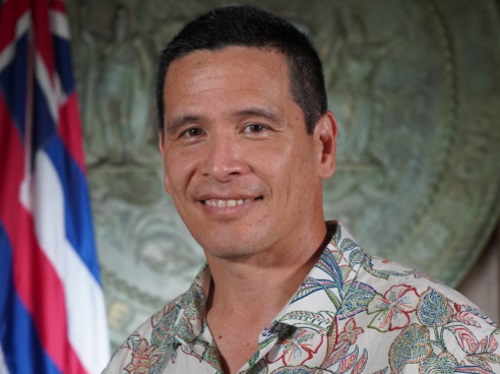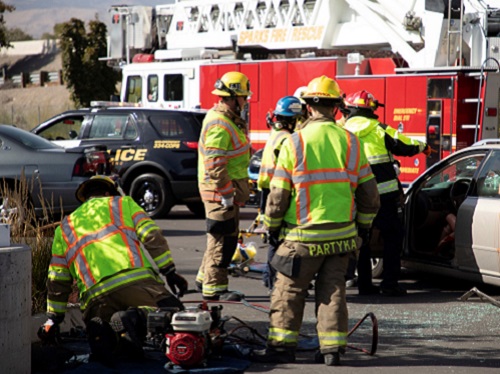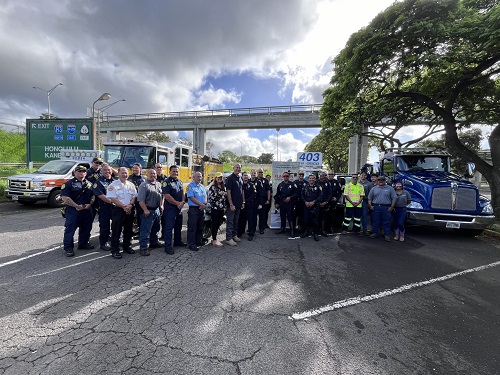Across the country, state departments of transportation helped host and participate in a number of events geared around the 2024 Crash Responder Safety Week campaign, held November 18-22.
[Above photo by the Hawaii DOT]
The Hawaii Department of Transportation and its traffic safety partners held a kickoff event at Aloha Stadium for the 2024 Crash Responder Safety Week campaign, with Governor Josh Green (D) and responders from the City and County of Honolulu Emergency Services Department, Honolulu Fire Department, Honolulu Police Department, Freeway Service Patrol, American Medical Response, and Advanced Towing in attendance.

“Last year there were 45 crash responders injured in motor vehicle crashes while in the line of duty on our roads,” said Ed Sniffen, Hawaii DOT director, in a statement. “If you’ve ever been stuck on the side of the road, you know it can be stressful. We all need to do better in watching out for the heroes working to help people in dangerous roadside conditions.”
Traffic incidents are the number one cause of death for emergency responders nationwide, he added, noting that in 2023 Hawaii witnessed seven tow truck operators, one emergency medical technician, and 37 police officers get injured in crashes while on duty.
Meanwhile, the Florida Department of Transportation highlighted the continued success of enhanced traffic incident management training and various safety countermeasures to reduce secondary crashes on Florida’s roadways.

“As experts in traffic incident management, Florida DOT’s ‘Road Rangers’ and other crash responders put their lives on the line each day to keep motorists safe thanks to their quick response and efficient scene clearance,” said Jared Perdue, Florida DOT secretary, in a statement. “These responders are a major part of the solution for creating safer roads through their reduction of secondary crashes, and [we are] proud to continue establishing new technology and initiatives to ensure that these responders and all motorists make it home safely.”
He noted that the reduction in secondary crashes on Florida’s roadways reflects his agency’s commitment to achieving its vision of eliminating serious injuries and fatalities from occurring on the state’s transportation system, as well as the tangible impact of high-quality traffic incident management training courses for Road Rangers.

Most recently, Florida DOT partnered with the Florida Department of Health to approve the National Traffic Incident Management Responder Training as a continuing education credit for emergency medical services or EMS professionals as part of their recertification process, encouraging greater integration of safe and efficient traffic incident management practices across multiple crash responder entities.
The agency is also using advanced notification systems through Dynamic Message Signs and third-party navigation apps, as well as the installation of truck-mounted debris removal systems on Road Ranger vehicles, the use of light emitting diode or LED flares and truck mounted attenuators, and the ongoing research and implementation of rear-facing red lights on these vehicles to enhance the visibility of responders when they are working on roadsides statewide.

Out west, the Nevada Department of Transportation and Nevada State Police reiterated that traffic incidents are the primary cause of death for police officers and emergency medical responders nationwide, with 45 roadside first responders struck and killed last year on the nation’s roads.
“The Nevada State Police Highway Patrol Division is committed to keeping our roadways safe for all, including motorists and those who are working along our roadways,” said Nevada State Police Highway Patrol Colonel Conmay in a statement. “Please slow down and move over for law enforcement, Nevada DOT, first responders and tow truck drivers.”
[Editor’s note: In July, the Nevada DOT hosted an inaugural traffic safety summit focused on the needs of rural communities across the state.]
National statistics show that for every minute a freeway lane is blocked, the resulting traffic congestion takes four minutes to clear, and the chance of secondary crashes increases.
To reduce the chances of such incidents, the Nevada DOT, Nevada State Police, local law enforcement, fire departments, public works, emergency medical responders, federal modal administrations as well as private towing and hazardous materials responders train together in regional traffic incident management or TIM coalitions to improve road incident response and roadway safety while reducing travel delays.
Since Nevada’s first TIM coalition was founded in southern Nevada, coalitions statewide have trained more than 79 percent of all Nevada road incident responders to implement consistent, safe, quick clearance of traffic incidents. More than 225 Nevada first responders have been trained in traffic incident safety thus far in 2024, the agency said.
 Nation
Nation
Registration Open for AASHTO’s Winter Rail Meeting
December 19, 2025 Nation
Nation

